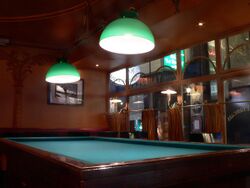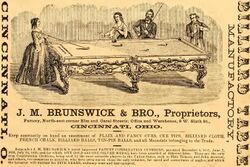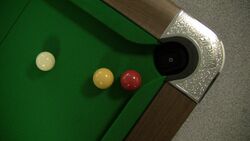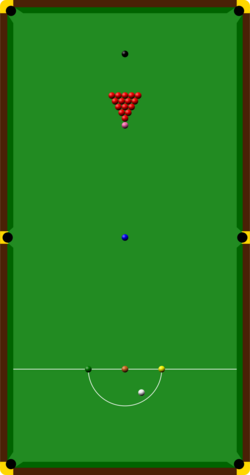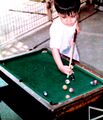Billiard table
Topic: Engineering
 From HandWiki - Reading time: 12 min
From HandWiki - Reading time: 12 min
A billiard table or billiards table is a bounded table on which cue sports are played. In the modern era, all billiards tables (whether for carom billiards, pool, pyramid or snooker) provide a flat surface usually made of quarried slate, that is covered with cloth (usually of a tightly woven worsted wool called baize), and surrounded by vulcanized rubber cushions, with the whole thing elevated above the floor.[1]:115, 238 More specific terms are used for specific sports, such as snooker table and pool table, and different-sized billiard balls are used on these table types. An obsolete term is billiard board, used in the 16th and 17th centuries.[1]:27[2]
Parts and equipment
Cushions
Cushions (also sometimes called "rail cushions", "cushion rubber", or rarely "bumpers") are located on the inner sides of a table's wooden rails. There are several different materials and design philosophies associated with cushion rubber. These cushions are made from an elastic material such as vulcanized rubber (gum or synthetic). The purpose of the cushion rubber is to cause the billiard balls to rebound off the rubber while minimizing the loss of kinetic energy.[citation needed]
The profile of the rail cushion, which is the cushion's angle in relation to the bed of the table, varies between table types. The standard on American pool tables is the K-66 profile, which as defined by the Billiard Congress of America (BCA) has a base of 1 3⁄16 inches (30 mm) and a nose height of 1 inch (25 mm).[3] When installed properly the distance from the nose of the cushion to the covered slate surface is 1 7⁄16 inches (37 mm)[4] while using a regulation 2 1⁄4-inch (57 mm) ball set.[citation needed]
On a carom table, the K-55 profile is used (with a somewhat sharper angle than pool cushions). K-55 cushions have cloth, usually canvas, vulcanized into the top of the rubber to adjust rebound accuracy and speed.[3]
Snooker tables use an L-shaped profile, such as the L77 profile.[citation needed]
Bed
The bed table – the cloth-covered, horizontal playing surface – is, on high-quality equipment, made of solid, smooth slabs of slate, most often from Italy, Brazil or China. Small pool tables may use only one or two pieces of slate, while carom, English billiards and tournament-size pool tables use three. Full-size snooker tables require five. The gap between slates is filled with a hard-drying putty, epoxy or resin, then sanded to produce a seamless surface, before being covered with the cloth. When several pieces of slate are joined poorly it is possible for the resin to deform and cause an uneven playing surface; it can also be difficult to move once joined.[citation needed]
Tables for the home market usually use slate beds as well, but the slate is often thinner, down to about 1⁄2 inch (13 mm). The early table beds were made of cloth-covered wooden boards. Today, inexpensive but not very rigid or durable materials used for the beds of low-end tables (e.g. for children's recreation rooms) still include wood, especially medium-density fibreboard and plywood, as well as plastics and other synthetic materials under various trade names.[citation needed]
Cloth
Billiard cloth (sometimes erroneously called felt) is a specific type of cloth that covers the top of the table's "playing area". Both the rails and slate beds are covered with 21–24-ounce billiard cloth (although some less expensive 19-ounce cloths are available) which is most often green in colour (representing the grass of the original lawn games from which billiards evolved), and consists of either a woven wool or wool-nylon blend called baize.[citation needed]
Most bar tables, which get much use, use the slower, thicker blended felt because it is cheaper. This type of cloth is called a woollen cloth. By contrast, high-quality pool cloth is usually made of a napless weave such as worsted wool, which gives a much faster roll to the balls. This "speed" of the cloth affects the amounts of swerve and deflection of the balls, among other aspects of game finesse. Snooker cloth traditionally has a directional nap, upon which the balls behave differently when rolling against vs. running with the direction of the nap.[citation needed]
Markings
Spots are often used to mark the head and foot spots on the cloth. Other markings may be a line drawn across the head string (or across the balk line with the "D", in British-style pool). Another case is the outline of the triangle rack behind the foot spot where the balls are racked in straight pool, since the outline of this area is strategically important throughout the game. In artistic pool, lines may be drawn between opposite sights putting a grid on the playing surface. Other grid patterns are used in various forms of balkline billiards. A recent table marking convention, in European nine-ball, is the break box.[citation needed]
Carom billiards tables
Pocketless carom billiards tables are used for such games as straight rail, balkline, one-cushion billiards, three-cushion caroms, and artistic billiards.[citation needed]
Dimensions
Regulation 10 × 5-foot carom billiards tables have a playing surface (measured between the noses of the cushions) of 2.84 by 1.42 metres (9.3 by 4.7 ft) with a 5-millimetre allowance.[5] The standard height range of the table, measured from the playing surface to the ground is between 75 and 80 centimetres.[citation needed]
Bed
The slate bed of a carom billiards table must have a minimum thickness of 45 millimetres and in tournaments recommended heating temperatures is 33–37 °C (91–99 °F), which helps to keep moisture out of the cloth to aid the balls rolling and rebounding in a consistent manner, and generally makes a table play faster. A heated table is required under international carom rules and is an especially important requirement for the games of three-cushion billiards and artistic billiards.[1]:115, 238
Pool tables
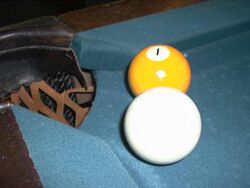
A pool table, or pocket billiards table, has six pockets – one at each corner of the table (corner pockets) and one at the midpoint of each of the longer sides (side pockets or middle pockets).
Dimensions
Pool tables come in different sizes, typically referred to as 9-foot (2.7 m), 8.5 ft (2.6 m), 8 ft (2.4 m), or 7 ft (2.1 m) tables. In all cases, the table is rectangular with a 2:1 ratio (e.g. 9 × 4.5 ft).[citation needed]
There are only two sizes approved for tournament play by the International Olympic Committee–recognized sport governing body of pool, the World Pool-Billiard Association (WPA), and its various regional and national affiliates; under the world standardized rules of pool, these are the 9 × 4.5 ft and 8 × 4 ft models.[6][3] For a 9-ft table, the playing surface (the dimensions between the noses of the cushions) measures 100 by 50 inches (254 by 127 cm) with a 1⁄8-inch (3.2 mm) margin of error for either dimension. For an 8-ft table, the playing surface measures 92 by 46 inches (234 by 117 cm), with the same 1⁄8 inch variance allowed.[citation needed]
In the UK as well as a number of other British Commonwealth and European countries, the typical pool table is a 7 ft × 3.5 ft (2.1 m × 1.1 m), although 6-foot (1.8 m) tables for the pub and home market are also common. These are the sizes used by internationally standardized blackball and the amateur World Eightball Pool Federation, as well as informal pub pool.[7] The 7-foot size is also frequently used in North American amateur leagues, and are common coin-operated fixtures in bars and other venues. The playing surface for a 7-foot table is 76 by 38 inches (193 by 96.5 cm).[citation needed]
Pockets
Pockets, typically rimmed at the back with leather or plastic traditionally have drop pockets, which are small receptacles below each pocket to contain the balls. More modern tables may instead employ ball return pockets, a series of gutters inside the table, which deliver the balls into a collection compartment on one side of the table, in a similar manner to the ball return on a bowling alley. On a coin-operated table, the object balls are deposited inside an inaccessible window until the table is paid again, allowing the balls to be released into the compartment, while the cue ball is usually separated into its own ball return, often utilizing a different sized ball. A possible result of drop pockets is that if too many balls go into the same pocket, it would fill up the receptacle and prevent any more balls from going in that pocket, requiring that some be moved out of the pocket manually before shooting again.[citation needed]
Regardless of table size, the WPA standard (sometimes informally called "American-style") table has wide, angular pockets that funnel notably inward, generally 1.75 to 2.25 times as wide at the opening as the diameter of the 2 1⁄4-inch (57 mm) balls, wider at the side (middle) pockets than the corners. WEPF pool (sometimes informally called "British-style" or "Commonwealth-style") is played with 2 to 2 1⁄8-in (51–54 mm) balls, and this type of table has smaller, narrow pockets (the width is calculated as the ball diameter multiplied by 1.6, and is consistent at all six pockets), with rounded entrances and nearly parallel sides, like those on a snooker table. One tactical consequence of this design difference is that the jaws of the WPA-type pocket are often used exactly like a horizontal version of the backboard of a basketball goal, to rebound the ball into the pocket; this technique does not work on blackball tables, and even shots down the cushion into a corner pocket are more difficult.[citation needed]
Bed
For tournament competition under WPA world-standardized rules (and league play under derived rulesets), the bed of the pocket billiard table must be made of slate no less than 1 inch (2.54 cm) thick. The flatness of the table must be divergent by no greater than 0.02 inches (0.51 mm) lengthwise and 0.01 inches (0.25 mm) across the width.[6]
Scoring device
Some pool tables may feature mechanical scorekeeper on one side, which can be changed to denote points for games such as straight pool or rotation.
Snooker and English billiards tables
A table designed for the games snooker and English billiards is usually called a snooker table.
Dimensions
The playing area of a tournament snooker table, as standardized by the World Professional Billiards and Snooker Association (WPBSA) and the amateur International Billiards and Snooker Federation (IBSF),[8][9] measures 11 feet 8.5 inches by 5 ft 10 in (3569 mm by 1778 mm) with a tolerance of ± 0.5 in (13 mm),[10] though commonly referred to as 12 ft by 6 ft, the nominal outer dimensions including the rails. Smaller tables, approximately 10 ft by 5 ft down to half size, are also sometimes used in pubs, homes and smaller snooker halls. The height from the floor to the top of the cushion is between 2 ft 9.5 in and 2 ft 10.5 in (851 mm and 876 mm).[10]
Pockets
A snooker table has six pockets, one at each corner and one at the centre of each of the longest side cushions. The pockets are around 86 mm (3.5 in),[clarification needed] though high-class tournaments may use slightly smaller pockets to increase difficulty. The amount of undercut (trimmed underside of the rubber cushion's protruding nose at the pocket opening),[11]:8 if any, has a strong effect on how easily a ball is accepted by the pocket (the "pocket speed"). On snooker and English billiards tables, the pocket entries are rounded, while pool tables have sharp "knuckles". This affects how accurate shots need to be to get into a pocket, and how fast they can be when not dead-on, including shots that run along and against a cushion, making snooker more difficult to play than pool. According to the WPBSA official rule book, "the pocket openings shall conform to the templates owned and authorised by The World Professional Billiards and Snooker Association (WPBSA)".[10] The WPBSA and IBSF rule books' equipment sections do not actually specify the measurements and shapes of these proprietary templates[9][10] which change from time to time, requiring that the templates be dated.[12] The organizations do not recognize tournament play or records (maximum breaks, etc.) if not performed on tables that conform to then-current templates.[12][13]
Cushions
The cushions (sometimes known as rails, though that term properly applies to the wood sections to which the cushions are attached) are usually made of vulcanized rubber.[citation needed]
Markings
Bed
Tables for other games
Other types of billiard tables are used for specific games, such as Russian pyramid which uses a '12 ft by 6 ft' table (similar to a snooker table but with much smaller pockets), and Asian four ball which uses a pocketless 8 ft by 4 ft table. Games such as bagatelle often had more than six holes, including straight through the bed in the middle of the table, a feature still found in bar billiards and bumper pool.[citation needed]
Novelty and home tables
There are novelty billiard tables, often for pool, that come in various shapes including zig-zag, circular, and (especially for bumper pool) hexagonal. A circular table featured prominently in the 1972 film Silent Running. For the home market, many manufacturers have produced convertible billiard tables (in the broad sense) that double as dining tables or as table tennis, foosball, or air hockey, tables, with removable hard tops.[14] Home pool tables, which often lack a ball-return system, are commonly either 4 × 8 ft or 3.5 × 7 ft models, a medium between 3 × 6 ft. bar/pub tables and 4.5 × 9 ft tournament-size models. Low-end tables tend toward the smaller range, and may have MDF or wood beds as an alternative to slate; those with light-weight beds may be foldable for storage, as with table tennis. Miniature tables range in size from tabletop 1 × 1.6 ft to free-standing 2.5 × 5 ft models, and use scaled-down cues and balls.[citation needed]
An original Ford Mustang converted into a novelty pool table, exhibited at the 2011 Montreal International Auto Show
Heating
Billiard table beds are commonly heated with electricity, in order to keep the cloth dry, and allow the balls to roll better.[15][16] Queen Victoria (1819–1901) had a billiard table that was heated using zinc tubes, although the aim at that time was chiefly to keep the then-used ivory balls from warping. The first use of electric heating was for an 18.2 balkline tournament held in December 1927 between Welker Cochran and Jacob Schaefer Jr. The New York Times announced it with fanfare: "For the first time in the history of world's championship balkline billiards a heated table will be used..."[1]:115, 238[17]
An electrically heated table is required under international carom billiard tournament rules 'in order to ensure the best possible rolling', although temperatures are not specified.[18] In tournaments, carom billiard tables have recommended heating temperatures of 33–37 °C (91–99 °F),[1]:115, 238 while billiard associations may heat their carom tables to as much as 45 °C (113 °F).[19] An average modern billiard heater has an output of 600 watts.[15] If it is not switched off outside operating hours, consumption is 3,500 kilowatt-hour (kWh) per year,[15][19] costing 525 euros (0.15 EUR/kWh).[15] Switching off a billiard table heater whenever it is not used can save more than 50% in energy consumption and costs; this can be done automatically with timers.[15] Another way to reduce energy consumption and costs is to use synthetic cloth rather than wool cloth, which requires much more energy to warm up.[16] A disadvantage of synthetic cloth may be that certain types of games, such as balkline, may result in damaging the synthetic cloth too quickly because of the way players hit the balls.[16]
The 2022 Russia–European Union gas dispute caused rising energy costs around Europe, making heating billiard tables almost prohibitively expensive.[19] The Royal Dutch Billiards Federation's director said in October 2022 that "billiard and snooker localities are simply incapable of affording these energy prices anymore, as heating a billiard costs about 3,500 kilowatts a year (...). At current energy prices, that is about 2,400 to 2,500 euros a year per billiard table."[19]
References
- ↑ 1.0 1.1 1.2 1.3 1.4 Template:Shamos 1999
- ↑ Everton, Clive (1986). The History of Snooker and Billiards (rev. ver. of The Story of Billiards and Snooker [1979] ed.). Haywards Heath, England: Partridge Press. pp. 8–11. ISBN 1-85225-013-5.
- ↑ 3.0 3.1 3.2 "BCA Equipment Specifications". Billiard Congress of America. http://www.bestbilliard.com/resources/specs.htm.
- ↑ "Pool Table Cushion Replacement". PoolFelt.com. http://www.poolfelt.com/cushrepl.html.
- ↑ "World Rules of Carom Billiard". UMB.org. Union Mondiale de Billard. 1 January 1989. https://files.umb-carom.org/Public/Rules/Carom_Rules.pdf.
- ↑ 6.0 6.1 "WPA Tournament Table and Equipment Specifications". World Pool-Billiard Association. http://www.wpa-pool.com/index.asp?content=rules_spec.
- ↑ "British vs. American Pool". Liberty Games. http://www.libertygames.co.uk/information/british_vs_american_pool.
- ↑ "Official Rules of the Games of Snooker and English Billiards". The World Professional Billiards & Snooker Association Limited. November 2014. http://www.wpbsa.com/wp-content/uploads/2016/03/official-rules-of-the-game.pdf.
- ↑ 9.0 9.1 "Rules of the Game of Snooker". Reims, France: International Billiards and Snooker Federation. 2011. http://www.ibsf.info/rules-snooker.shtml.
- ↑ 10.0 10.1 10.2 10.3 Template:WPBSA 2011
- ↑ Stooke, Michael P. (14 March 2010). "Definitions of Terms used in Snooker and English Billiards". SnookerGames.co.uk. Dorset, England: self-published. http://www.snookergames.co.uk/glossary1.html. This tertiary source reuses information from other sources without citing them in detail. Stooke is a snooker instructor and writer whose work appears to be presumptively reliable, based on the sources he does cite throughout his materials.
- ↑ 12.0 12.1 "Standard Size of the Snooker Table". Delhi, New Delhi, India: India Cue Sports Society. 1995. http://pooltableindia.weebly.com/snooker-table.html.
- ↑ "Maximum Breaks (Professional Competition Only)". FCSnooker.co.uk. Preston, England: The Frank Callan Suite. 2009. "Unofficial 147s" section. http://www.fcsnooker.co.uk/latest%20links/147_breaks.htm. FCS is a snooker equipment manufacturer that also runs a snooker statistics site.
- ↑ Cite error: Invalid
<ref>tag; no text was provided for refs namedthemenscave - ↑ 15.0 15.1 15.2 15.3 15.4 "Tijdschakelklok voor biljartverwarming" (in nl). Vereniging Milieu Platform Zorgsector. https://milieuplatformzorg.nl/bibliotheek/maatregelen/937/tijdschakelklok-voor-biljartverwarming/. Retrieved 12 October 2022.
- ↑ 16.0 16.1 16.2 Sarah Wouters (17 September 2021). "Met deze investeringen bespaart biljartvereniging Horna energie" (in nl). Duurzame Sportsector.nl. https://www.duurzamesportsector.nl/artikel/met-deze-investeringen-bespaart-biljartvereniging-horna-energie/.
- ↑ "To Heat Table for First Time in World Title Billiard Match". The New York Times. 16 December 1927. https://www.nytimes.com/1927/12/16/archives/to-heat-table-for-first-time-in-world-title-billiard-match.html. (Subscription required.)
- ↑ "World Rules of Carom Billiard". Union Mondiale de Billard. Sint-Martens-Latem, Belgium. 1 January 1989. Chapter II ("Equipment"), Article 11, Section 9. http://www.umb.org/Rules/Carom_Rules.pdf.
- ↑ 19.0 19.1 19.2 19.3 "Biljarttafels moeten verwarmd, en dus zitten clubs nu in de geldproblemen" (in nl). NOS.nl. 11 October 2022. https://nos.nl/video/2447893-biljarttafels-moeten-verwarmd-en-dus-zitten-clubs-nu-in-de-geldproblemen.
 |
 KSF
KSF